- Series:Animals, God’s Design, Transcript English
One would not think that a brightly colored, relatively slow butterfly has much of a chance against a bird moving in for lunch. But you would be surprised. Scientists were.

Some butterflies are protected by distinctive, bright markings that indicate they are poisonous. But what about those butterflies that are bright and tasty?
Tropical birds that eat butterflies are usually fast and very agile fliers. They often have long, pointed beaks well designed to catch butterflies. It would seem that butterflies wouldn’t have a chance against faster-flying birds. In truth, it’s the bird that has the greatest disadvantage. The muscles that control the tasty butterfly’s wing are relatively stronger in terms of lifting power than a bird’s muscle. In addition, tasty butterflies have about 50 percent more flight muscle than the poisonous butterflies that birds avoid. Since butterflies weigh so much less than birds, they can change direction more rapidly. So even though a bird can fly much faster than a butterfly, by flying in a tight, darting, erratic pattern, a skillful butterfly can easily escape.
Not only is the butterfly wonderfully designed, it’s designed in view of the birds that might eat it. Notice how God carefully countered the bird’s advantage of speed by giving the butterfly stronger muscles and a more maneuverable body. Darwinism can only pretend to explain that!
Psalm 104:27
“These wait all upon thee; that thou mayest give [them] their meat in due season.
Prayer: I thank You, Lord, for the beauty of both the butterfly and the bird. I also thank You that You are a personal God Who cares about everything You have made. Fill my heart with the same love toward all You have made. Amen.
Notes: James H. Marden. “Newton’s Second Law Of Butterflies.” Natural History 1/92, pp. 54-60. Photo: Butterfly (PD)
© 2024 Creation Moments. All rights reserved.
